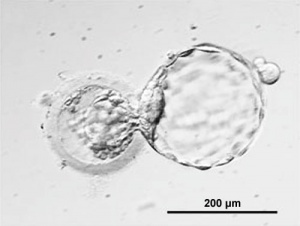K12 Stem Cells: Difference between revisions
No edit summary |
|||
| (12 intermediate revisions by the same user not shown) | |||
| Line 7: | Line 7: | ||
'''What are "stem cells" and why are they so important?''' | <center>'''What are "stem cells" and why are they so important?'''</center> | ||
::''Draft page. Content under development.'' | ::''Draft page. Content under development.'' | ||
| Line 20: | Line 21: | ||
| colspan="2"|[[File:Mark_Hill.jpg|50px]] This is currently only a draft designed to help K12 students understand comparative embryology. | | colspan="2"|[[File:Mark_Hill.jpg|50px]] This is currently only a draft designed to help K12 students understand comparative embryology. | ||
I am currently looking to simplify concepts and include images on this page. I am happy to receive feedback as too what you may like to be included here. I | This is a very large topic, with many different concepts to explain. This page will focus mainly on the biological issues and even that may be beyond teh scope of a simple one page explanation. | ||
I am currently looking to simplify concepts and include images on this page. I am happy to receive feedback as too what you may like to be included here. | |||
I will also add some simple exercises that can be used in class to help understand concepts on stem cells. Note some of the links on this page leave the K12 notes section and may be beyond the level of your students, bookmark this page to easily return here. This page can be printed using the lefthand menu "Toolbox" or [http://embryology.med.unsw.edu.au/embryology/index.php?title=K12_Stem_Cells&printable=yes Printable version]. | |||
--[[User:Z8600021|Mark Hill]] 09:25, 11 October 2012 (EST) | --[[User:Z8600021|Mark Hill]] 09:25, 11 October 2012 (EST) | ||
|} | |} | ||
==The Nobel Prize in Physiology or Medicine 2012== | |||
Awarded jointly to [[Embryology_History_-_John Gurdon|'''Sir John B. Gurdon''']] and [[Embryology_History_-_Shinya_Yamanaka|'''Shinya Yamanaka''']] "''for the discovery that mature cells can be reprogrammed to become pluripotent.''" | |||
{| | |||
| colspan=2|John Gurdon (a UK scientist) in the 1960's used a frog egg and cells from an adult frog to show that the adult cell nucleus can replace the egg nucleus and then develop normally into a tadpole then frog. | |||
| | |||
|- | |||
| [[File:Frog_eggs.jpg|150px|Frog Eggs]] | |||
| [[File:Frog-icon.png|150px|Adult Frog]] | |||
|- | |||
| Frog Eggs | |||
| Adult Frog | |||
|} | |||
* Shinya Yamanaka (a Japanese scientist) in 2006 identified just 4 proteins are required to turn any cell into a stem cell. | |||
[[Stem_Cells_-_Induced|Induced Stem Cells]] | |||
==University Level Information== | ==University Level Information== | ||
{{Stem Cell Links}} | |||
| Line 45: | Line 69: | ||
{{External Links}} | {{External Links}} | ||
* Boston Childrens Hospital - [http://stemcell.childrenshospital.org/about-stem-cells/history/| Stem Cell Timeline] | |||
{{Footer}} | {{Footer}} | ||
Latest revision as of 09:08, 11 October 2012
Introduction
| Everywhere in the news today you here the word "Stem Cell", it appears in the news of science, medicine, politics, religion, ethics, law and just recently as the 2012 Nobel Prize.
The Nobel Prize in Physiology or Medicine 2012Awarded jointly to Sir John B. Gurdon and Shinya Yamanaka "for the discovery that mature cells can be reprogrammed to become pluripotent."
University Level Information
Embryonic Stem Cells
Adult Stem CellsInduced Stem CellsExternal LinksExternal Links Notice - The dynamic nature of the internet may mean that some of these listed links may no longer function. If the link no longer works search the web with the link text or name. Links to any external commercial sites are provided for information purposes only and should never be considered an endorsement. UNSW Embryology is provided as an educational resource with no clinical information or commercial affiliation.
Cite this page: Hill, M.A. (2024, April 16) Embryology K12 Stem Cells. Retrieved from https://embryology.med.unsw.edu.au/embryology/index.php/K12_Stem_Cells
|
|||


